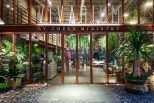A restaurant became quickly one of the most renowned of the entire Bangkok, son of a project that could…

THE PLACE TO BE. Since B&B Italia has the ability to build a path and keep with its loyal designers and audience the “fil-rouge” of its history and DNA, which is that of creating furnishings that express research, innovation and creativity.
Faithful to its roots but open to new ideas, this year B&B Italia presents a series of authentic new projects that took considerable time and energy for research, design, development, testing, finalizing and change course, if necessary.
These are exciting stories, because the challenge is to create something that lasts through time and is appreciated by an international public, but that also fills real needs, be they stylistic or functional. In many cases, this goal coincides with the evolution of a model that is modified and increased in the number of variants, growing not only in terms of items but also in quality and performance. Behind this there is also an ethical dialogue based on the conviction that each project is an asset, which must not be wasted.
With Michel Effe, the new seating system by Antonio Citterio, an important chapter is added to the successfull story that started in 2012 with Michel, the first modular sofa from the series. Born floating with its high foot and seat volumes, it continues to be the choice of people who love modernity, and those who prefer furnishings that hide their solidity behind an image of lightness. Last January, Michel Club was presented as an evolution of Michel. The orientation towards a new formal and technical typology that resizes the proportions of the frame and the cushions makes it a more traditional yet contemporary design proposal. The structure is higher and corresponds to a lowering of the support elements to offer a lounge type seat. The variety of the elements allows an extremely flexible interpretation of the living space and offer compositions with different functions ranging from familiar to formal. Comfortable back cushions with a headrest and additional cushions in various sizes make the seating relaxing or suitable for conversation, always comfortable and very elegant. And now Michel Effe, which is the brand new proposal from the series. Some of the characteristics are unaltered, such as the two depths, but it is more essential than its predecessors. It reveals a new design thanks to a simplification of the seat with a single cushion. It is thinner, but not less comfortable. Everything superfluous has been eliminated, but its 36 modular elements and 5 ottomans, along with four linear sofas, allow for a wide range of configurations. The frame is presented in the new pewter painted finish, which is added to the black chromed and the bronzed nickel painted that are already in collection.
With the table Oskar, Vincent Van Duysen enters the more architectural tradition of the furnishing project, considering the experience of the masters and presenting a piece that can dialogue with the space around it. The relation between the top and the legs based on a certain distance, the design of the frame that “captures” the legs, the curves of the rounded tops, the tapered edges, and the smoothed legs: all elements that involve considerable complexity in design, but with a result of great purity. Proportions, interplays with volumes and materials, all contribute to the table harmony. Among the materials, we can distinguish the top in cathedral glass with its irregular surface and light greenish colour, which can be an alternative to white Statuarietto marble, black Marquinia marble, natural woods or lacquered finishes. The legs are in natural or lacquered wood, also in the new glossy emerald green version, available only in combination with the cathedral glass top. Oskar is in three sizes: two rectangular and one square.
Also by Vincent Van Duysen, the new Surface drawer units which take all the combinations of materials and finishes from the previous series of small tables.
Three new chairs offer different solutions to a theme that continues to fascinate designers.
Charlotte by Antonio Citterio is a tribute to lightness. The shell is completely covered, but the aluminium frame profile is visible on the chair side, thus highlighting the line of the seat. The cover is in raw cut thick leather in six different colours (natural, black, dark brown, bordeaux, bottle green, mud green) with an “elephant” printed surface. The aluminium frame presents a series of different finishes that emphasize it when bright brushed, pewter painted and nickel bronzed, or make it monochromatic when it comes in bottle green and bordeaux colours.
Papilio Shell by Naoto Fukasawa is linked through its name to the previous family of very successful chairs and armchair by the Japanese designer, but has an independent history. Originating from a shell with a design that enhance comfort, it expresses considerable versatility that makes it perfect in different situations, not just at home. Papilio Shells is available in two versions: with plastic shell in three colours (white, dove gray, black) or padded and upholstered in a wide range of fabrics and leathers. Different types of bases give the chair different looks for different uses. The chromed or painted tubular legs simplify the piece, and when combined with the plastic shell make the chair stackable. The legs in oak wood, in many different variants, make it more sophisticated. The aluminium star base, in bright brushed or painted aluminium, with or without castors, gives the chair a more technical look.
Husk by Patricia Urquiola is presented in new versions in addition to the chair with die-cast legs already in collection. The new variants extend its use and change the perception of the piece. Now the base can be in oak wood (light, black, grey and smoked), or with a four-star base in aluminium, with or without castors, in a wide range of finishes.




